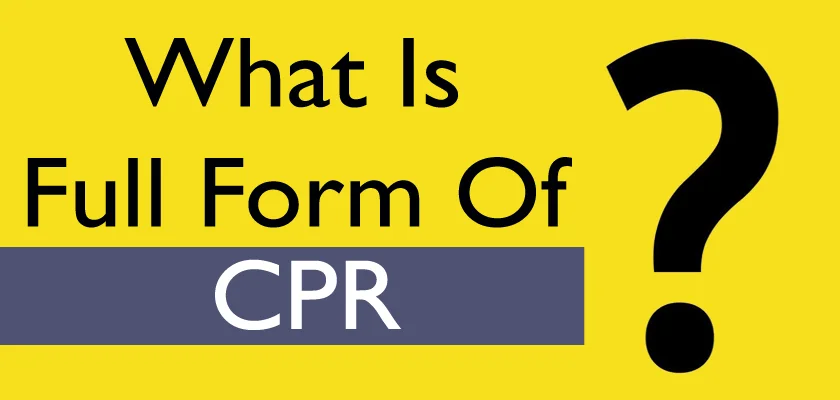Do you know what is the CPR Full Form? CPR Full Form is Cardio Pulmonary Resuscitation. CPR is a lifesaving technique that’s used in heart attacks and irregular or stopped breathing. Cardiac Arrest is a critical situation that happens when someone caused from a heart condition, suffocation, drowning, electrical shock etc. In CPR Full Form cardio relates to the heart, pulmonary relates to the lungs, and Resuscitation refers to revive.
Table of Contents
What is the Full Form of CPR?
CPR Full Form: Cardio Pulmonary Resuscitation
- Cardio- Heart
- Pulmonary- Lungs
- Resuscitation- Revive
What is CPR?
In the CPR process patient requires a combination of rescue breathing and chest compression.
- Rescue breathing provides oxygen to the patient’s lungs.
- The contraction in the patient’s chest maintains oxygen and blood circulation to the heart and lungs.
CPR performs chest compressions to keep brain activity intact. This is necessary because it is a type of manual unnatural ventilation to pump blood and circulate oxygen throughout the body. In this artificial ventilation, the patient’s chest should be compressed at least 5 cm deep and in this position, contractions should be done at a rate of 90 to 120 per minute.
In addition, air should also be expelled from the patient’s mouth during mouth-to-mouth avoidance. A machine that pumps air into the patient’s lungs is also used to provide mechanical ventilation to the patients. When CPR is given by an untrained rescuer, it is always advisable to choose chest compressions rather than mechanical ventilation as a better option. However, chest compressions can be problematic in children because the respiratory system is basically the source of illness rather than the heart.
CPR is not responsible for resuscitating the heart; its primary purpose is to get oxygen-rich blood flowing to the heart and brain. Because blood is the only way to supply oxygen throughout the body. And it protects brain tissue and cells and keeps the heart beating until medical supplies arrive.
Defibrillation is one of the mechanical methods of heart resuscitation, which involves the use of an electric shock to restore the patient’s heart rhythm back to normal. Defibrillation is only effective for heart rhythms, they are:
- Ventricular fibrillation
- Pulseless ventricular tachycardia
The patient is given CPR until the patient is either certified dead or the patient’s heart rate has resumed normal and spontaneous circulation.
What are the Precautions Measures for CPR?
There are a few things to keep in mind before giving CPR to a patient:
- We must determine if doing the CPR procedure is safe.
- If there are two helpers on location, one must be contacted in case of emergency, while the other must do CPR.
- Whether the patient is conscious or unconscious must be confirmed.
- The performer of CPR should have knowledge of the three letters C, A, and B. The American Heart Association established the abbreviations C for compression, A for airway, and B for breathing.
What is the procedure of CPR?
CPR may be done without any specialized tools. You only need to follow the steps below in the correct sequence or order:
- Compression
- Airway
- Breathing
In addition, the patient must be in a non-active position (lying on his or her back on a firm surface) to perform CPR for you. As a result, performing CPR will be simple and effective as the sternum can be effectively constricted. CPR is less effective on a soft surface like a mattress. Additionally, in order to properly compress the chest, the person performing the chest compressions must be positioned sufficiently high.
What is the Importance of CPR?
These are the following benefits of CPR:
- CPR is performed until the patient is pronounced dead or the heartbeat returns to normal.
- Thus, it is imperative to sustain breathing and blood circulation until the arrival of medically qualified aid, and CPR can be used to do so. If blood circulation is interrupted, permanent death or brain damage will advance quickly.
- When CPR is performed during the first six minutes after a person’s heart beating stops, CPR can keep them alive until medical care arrives.
- Any qualified person may do CPR involving external chest compressions and respiratory rescue.
Where to learn CPR Training?
Learning CPR is not difficult but you should learn it properly because the wrong way of doing CPR can damage the patient’s respiratory system and sternum. You can learn CPR training from many certified medical facilities and training camps as well as you learn CPR training from the Internet.

Other CPR Full Forms list
Read the list of all other CPR full forms here-
| Term | Full Form | Category |
| CPR | Cardiopulmonary Resuscitation | Medical |
| CPR | Customary, Prevailing, and Reasonable | Healthcare |
| CPR | CHHAPRA | Indian Railway Station |
| CPR | Corrosion Penetration Rate | Chemistry |
| CPR | Cash Position Recovery | Accounts and Finance |
| CPR | Constant Prepayment Rate | Accounts and Finance |
| CPR | Credit Pro-Rate | Accounts and Finance |
| CPR | Chairman’s Program Recommendation | Military and Defence |
| CPR | Close Proximity Recovery | Military and Defence |
| CPR | Cost Performance Report | Military and Defence |
| CPR | Command Performance Review | Military and Defence |
| CPR | Combat Power Radio | Military and Defence |
| CPR | Cardio-pulmonary Resuscitation | Military and Defence |
| CPR | Contents of Previous Register | Computer Assembly Language |
| CPR | Constructed Product Result | Maths |
| CPR | Casper (wy) | Airport Code |
| CPR | Critical Problem Report | Space Science |
| CPR | Coffee Provides Refreshment | Messaging |
| CPR | Commission Prospecting and Rejection | Job Title |
| CPR | Corrected Points Rating | Sports |
| CPR | Corel Presents Presentation File | File Type |
| CPR | Civil Procedure Rules | Law |
What Are the Three Different Types of CPR?
CPR, or cardiopulmonary resuscitation, is an essential life-saving technique that is used to keep someone alive when they are in cardiac arrest. Knowing how to perform CPR is an essential skill, and there are three different types of CPR that are used depending on the situation.
The first type of CPR is called conventional CPR, and it’s the most common type. This type of CPR involves 30 chest compressions followed by two rescue breaths. The chest compressions help to circulate oxygenated blood throughout the body, while the rescue breaths help to restore breathing. This type of CPR is used for adults, children, and infants who are not breathing.
The second type of CPR is called hands-only CPR. This type of CPR does not involve rescue breaths and is used for adults who have gone into cardiac arrest. With hands-only CPR, you perform continuous chest compressions at a rate of 100-120 per minute. This type of CPR is used when there is no one available to administer rescue breaths, or when the person administering CPR is not trained in conventional CPR.
The third type of CPR is called CPR with an automated external defibrillator (AED). This type of CPR is used when a person is in cardiac arrest and an AED is available. An AED is a device that is used to shock the heart back into a normal rhythm. With CPR with an AED, you perform chest compressions and use the AED to deliver shocks to the heart.
Knowing how to perform all three types of CPR is an essential life-saving skill. All three types of CPR can be used to help save someone’s life in different situations. It is important to take a CPR class to learn how to perform each type of CPR correctly.
FAQs- What is the full form of CPR
What is the full form of CPR in Medical?
In the Medical sector, the CPR Full Form stands for Cardiopulmonary Resuscitation.
What is the full form of CPR in Hindi?
In Hindi, the full form of CPR is हृत्फुफ्फुसीय पुनर्जीवन.
What is the full form of CPR in text and chat?
In texting the full form of CPR stands for Cardiopulmonary Resuscitation, and in chat, the full form of CPR is Coffee Provides Refreshment.
What is the cpr training full form?
In training, CPR stands for Cardiopulmonary Resuscitation.
Thanks for reading What is the CPR Full Form? Bookmark our website Whatisfullform.com to know or read our collection of full forms.


